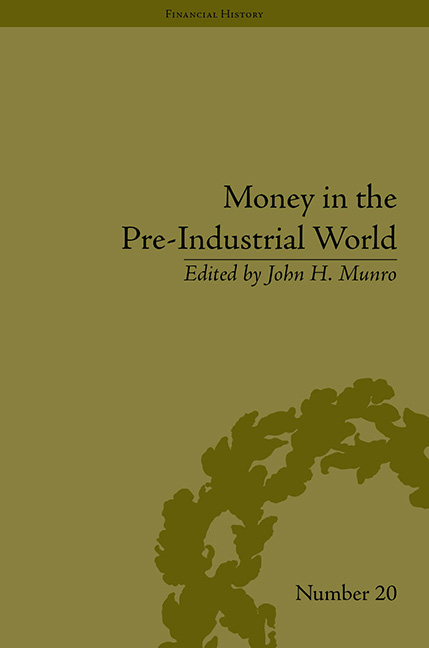Book contents
- Frontmatter
- CONTENTS
- List of Figures and Tables
- List of Contributors
- Introduction
- 1 The Technology and Economics of Coinage Debasements in Medieval and Early Modern Europe: with Special Reference to the Low Countries and England
- 2 From Aurelian to Diocletian: Financing Imperial Recovery by Coinage Debasements and Fiduciary Currencies
- 3 The Making of a Gold Standard: The Ducat and its Offspring, 1284–2001
- 4 Debasement of the Coinage and its Effects on Exchange Rates and the Economy: in England in the 1540s, and in the Burgundian-Habsburg Netherlands in the 1480s
- 5 The Amsterdam Wisselbank's Innovations in the Monetary Sphere: The Role of ‘Bank Money’
- 6 Silver in England 1600–1800: Coinage Outputs and Bullion Exports from the Records of the London Tower Mint and the London Company of Goldsmiths
- 7 The Burdens of Tradition: Debasements, Coinage Circulation and Mercantilist Public Policy Debates in Seventeenth-Century Aragon
- 8 Money or Export Commodity for Asia? American Silver in the Markets of Mexico, Castile and Amsterdam from the Sixteenth to the Eighteenth Century
- 9 Cacao Beans in Colonial México: Small Change in a Global Economy
- 10 Precious Metals, Debasements and Cowrie Shells in the Medieval Indian Monetary Systems, c. 1200–1575
- Notes
- Index
6 - Silver in England 1600–1800: Coinage Outputs and Bullion Exports from the Records of the London Tower Mint and the London Company of Goldsmiths
- Frontmatter
- CONTENTS
- List of Figures and Tables
- List of Contributors
- Introduction
- 1 The Technology and Economics of Coinage Debasements in Medieval and Early Modern Europe: with Special Reference to the Low Countries and England
- 2 From Aurelian to Diocletian: Financing Imperial Recovery by Coinage Debasements and Fiduciary Currencies
- 3 The Making of a Gold Standard: The Ducat and its Offspring, 1284–2001
- 4 Debasement of the Coinage and its Effects on Exchange Rates and the Economy: in England in the 1540s, and in the Burgundian-Habsburg Netherlands in the 1480s
- 5 The Amsterdam Wisselbank's Innovations in the Monetary Sphere: The Role of ‘Bank Money’
- 6 Silver in England 1600–1800: Coinage Outputs and Bullion Exports from the Records of the London Tower Mint and the London Company of Goldsmiths
- 7 The Burdens of Tradition: Debasements, Coinage Circulation and Mercantilist Public Policy Debates in Seventeenth-Century Aragon
- 8 Money or Export Commodity for Asia? American Silver in the Markets of Mexico, Castile and Amsterdam from the Sixteenth to the Eighteenth Century
- 9 Cacao Beans in Colonial México: Small Change in a Global Economy
- 10 Precious Metals, Debasements and Cowrie Shells in the Medieval Indian Monetary Systems, c. 1200–1575
- Notes
- Index
Summary
Debasement has always commanded a high degree of interest among historians, and rightly so. Strong currencies of high intrinsic worth are associated with successful trading nations, but also have connotations of probity and high moral worth. Reductions in the intrinsic content of the coinage seem in contrast to speak of spendthrift government policies, and dissolute behaviour born of lax personal and national standards of behaviour. Debasement is also often associated with deception and downright fraud, since the extent of the reduction in intrinsic content was often concealed from the public. Nevertheless, despite such attempted secrecy, debasements usually resulted in some (unpredictable) degree of price inflation, which was almost always widely unpopular.
Debasement undermines the functions and use of money in all its principal respects. Whether money was used as a measure or store of value, its alteration obviously reduced its ability to fulfilits core functions. Debasement also disrupted the operation of money as a medium of exchange, arguably its principal use in medieval and early modern societies. It introduced uncertainty, created winners and losers, and undermined confidence in established social and economic values, in both domestic and international trade and certainly also for all payments made for factors of production (labour, land, capital).
Nevertheless, despite the unpopularity of debasement, consideration of the needs of commerce leads to a more rounded view, which recognizes that reduction in the intrinsic content of the money was not in every case mistaken. Indeed, it is clear that in certain circumstances a currency might be too strong. Rather than simplistically declaring sound money to be good and weak money to be bad, a more sophisticated analysis is required which also considers how far the currency was capable of supplying the needs of the economy.
This chapter, rather than charting the sorry progress of debasement and its effects, looks instead at a period of English history in which too much stress may have been laid on the importance of retaining a high value silver coinage of unchanging worth, despite major shift s in the international values of precious metals.
- Type
- Chapter
- Information
- Money in the Pre-Industrial WorldBullion, Debasements and Coin Substitutes, pp. 97 - 110Publisher: Pickering & ChattoFirst published in: 2014



